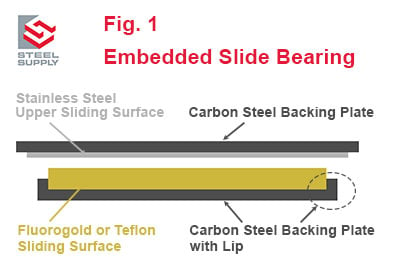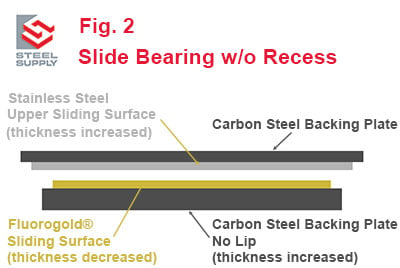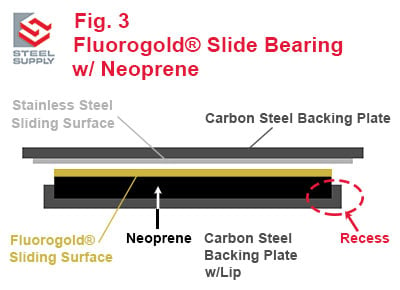Embedded Slide Bearings
Recessed or Shouldered into the Backing Plate.
Return to Slide Bearings Main Page
Note; This section deals with Fluorogold®, Teflon® and PTFE Slide Bearings that call for the sliding material to be embedded into the backing plate. This is not to be confused with the RECESSED LIP slide bearing.
An embedded Slide Bearing is one with the Teflon®, Fluorogold® or PTFE secured in a cavity on the backing plate. Figure 1 shows the lip of the recessed area for the sliding surface. In this example the lower element is made from 1/4" steel and 1/4" Fluorogold®. The lower steel backing plate has been milled so the area where the Fluorogold® is bonded is 1/8" thick. The overall height of the lower element is 3/8".
This is a design that is used when the Teflon® material is thick enough that lateral bulging or sideways bearing creep may become a problem. Teflon® or PTFE at 1/4" thick may be subject to this condition. Fluorogold®, because it is infused with fiberglass, has exceptional stability and wear resistance. It is usually specified at 3/32" thick and this provides the durability to satisfy the required longevity of the bearing an eliminate the possibility of lateral expansion. Reducing the thickness of the Fluorogold® to 3/32" will require adjusting the thickness of at least one other component to maintain the required height of the assembly. Fig. 2.
Where the embedded bearing more useful is when the Fluorogold®, Teflon® or PTFE is bonded to a neoprene rotation or vibration isolator pad. Fig. 3. To function the neoprene needs to be flexible enough to respond to the energy the upper member delivers. Left without shoulders to hold it in place the neoprene can bulge or begin to flatten out. It can also distort in response to lateral movement by the upper member. To maintain the desired flexibility and at the same time control distortion the designer may require the bottom steel backing plate be recessed to form a shoulder around the neoprene.
Constructed as shown in fig. 3, to function correctly the shoulder should be snug against the neoprene perimeter. Due to the extra time and labor involved in this manufacturing process when lateral distortion is a factor, designers will often eliminate the shoulder and employ an Elastomeric Bearing Pad. This is a specially designed bearing made of layers of steel separated and encased in Neoprene Rubber. The rubber provides for rotation and lateral flexibility while the steel layers prohibit distortion.






